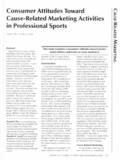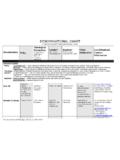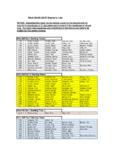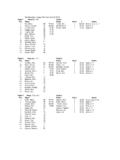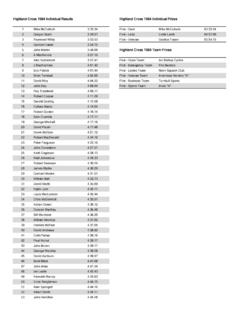Transcription of managers and executive The impact and …
1 The impact and effectiveness ofadvertisements in a sports TurleyProfessor of Marketing, gordon Ford College of Business, WesternKentucky University, Bowling Green, Kentucky, USAJ. Richard ShannonAssociate Professor of Marketing, gordon Ford College of Business,Western Kentucky University, Bowling Green, Kentucky, USAK eywordsAdvertising, Consumer behaviour, SportsAbstractExplores the effects of advertising in a sports arena on message recall,purchase intentions, and actual purchase behavior. The findings from this study suggestthat consumers can recall at least some of the ads they are exposed to in these captivesituations but most do not produce any lasting memory trace. The data also indicate thatseveral independent variables, most notably frequency of exposure to the advertisingmessage, are positively associated with recall, purchase intentions and actual purchasingbehavior. The findings from this study indicate that advertisements in this setting canhave an impact on the behavior of consumers.
2 However, more research is needed in thissetting to identify specific execution variables which differentiate between ads whichcreate an impact , and those that do the last several decades, advertisers have been facing a fragmentingmass media which has forced them, at times, to consider alternative methodsfor communicating with consumers. Marketers have noted that in somesituations consumers spend extended time, almost as captives, in a particularsetting and have been using these extended situations as a means forexposing these consumers to advertising messages. In this context, a captiveservice setting is characterized by an extended stay in a service facility orplace where consumers cannot normally leave before the service has beenperformed, or they are reluctant to do so. In addition, when a person entersthis setting they are often involuntarily exposed to advertising messages. In arare study of captive audiences, Brand and Greenburg (1994) studied theeffects of commercial messages aimed at middle- and high-school studentsin the classroom.
3 Other examples of captive settings include airportterminals, bus and subway stations, and sports most other marketing facilities these environments can be cognitivelycomplex. Most of the atmospheric or environmental research in marketinghas occurred in more traditional retail stores, and an extensive review of thisliterature has shown that consumers react to, and are influenced by, theatmosphere they are in (Turley and Milliman, forthcoming). In these captivesettings the ads must compete for attention with the other aspects of theatmosphere which is created by the facility, and the other people who are init. However, since consumers often spend extended time, up to several hours,these ads can received prolonged or repeated exposure even though they areoften in the background. From a marketing perspective, the ultimatequestions are how much processing of these ads is occurring by people inthese types of environments, and what effects, if any, do these ads have onattitudes and consumer behavior?
4 , , ,#MCBUNIVERSITYPRESS, , ,however, (Schlossberg,1991).However, ,towhatextentcanconsumersrecalltheadsthe yseeinthistypeofsetting?Second,dothesead sinfluencepurchasingintentions?Finally,d otheyhaveanyeffectontheactualpurchasingb ehaviorofconsumers?LiteraturereviewAtpre sent, ,particularlyatmospherics, (1975),McKinnonetal.(1981),andPatton(198 1)foundthatthesein-storesignsinfluencedi temssales,whileCurhan(1974) ,inthesesituationsthesignswereexposedtoc onsumersatthepoint-of-salesothattheinfor mationinthesignsdidnothavetobeprocesseda ndstoredinlong-termmemoryforafuturedecis ion, ,inasportsarenathereareoftenarelativelyh ighnumberofstimulicompetingforaperson' ,danceteams,mascots,otherfansatthegame,v endors,thepublicaddressannouncers,refere es, (WakefieldandBlodgett,1994),repurchasein tentions(WakefieldandBlodgett,1994;Wakef ieldandSloan,1995;Wakefieldetal.,1996),d esiretostayinafacility(WakefieldandSloan ,1995;Wakefieldetal.,1996),pleasure(Wake fieldetal.)
5 ,1996),andperceivedvalue(WakefieldandBar nes,1966).However, ,CrimminsandHorn(1996) 's(1994) ,theymayhavefailedtorecognizethatthiscap tiveaudienceisinafacilityforaverylongper iodoftimeandislikelytonoticeandprocessin formationintheadsanumberoftimesovertheco urseofaEmotionallychargedenvironmentAtmo sphericsstudiesHighnumberofstimuli324 JOURNALOFSERVICESMARKETING, ,astudybyStotlarandJohnson(1989) ,theauthorsreportedthatbasketballfanshad higherlevelsofadvertisingrecognitionthan footballfans, (1993)studiedadifferentkindofsportsfacil ity,anLPGA golfcourse,andfoundthatalthough91percent oftheirsampledidnotlookforads, (1996) , ``controlledevent'',slidesofavolleyballg ame,andtesteddifferenttypesofpromotional activitieswhichadvertisersoftenuse(McCar villeetal.,1998).Thepromotionaloptionsin thisstudyincludedanondirectedmessage(alo go),adirectedordetailedmessage, 's1912studyisoftenrecognizedastheearlies tstudyofadvertisingrecall,butthistopicha scontinuedtointerestresearchersinpsychol ogy, ,themostinfluentialfindingshavedeveloped asaresultoftheAdvertisingResearchFoundat ion's(ARF)1956studyofPrintedAdvertisingR atingMethods(PARM)(BagozziandSilk,1983).
6 Afterstudyingthedatafromthe1956article,L ucas(1960)concludedthatrecallcouldbecons ideredameasureofmemory,butrecognitionsho uldImpactonsportsfansProductssoldinsidea renaRecognitionandrecallJOURNALOFSERVICE SMARKETING, (1964)carriedoutadditionalanalysesofthed atafromthePARM studyandconcludedthat``recallscoresaremo reobjectiveandthereforemoretrustworthyth anrecognitionscores.''Morerecentresearch indicatesthatmemorytracesforadscanlastfo r11yearsorlonger(BozinoffandDacin,1985). Recallcanbemeasuredusingtwoapproaches,ai dedorunaidedrecall(Boveeetal.,1995). ,ontheotherhand, (BerkmanandGilson,1987).Priorresearchhas investigatedtherecallofadshasinanumberof differentcontextsincludingprintadvertise ments( ,1983),televisioncommercials(Schlingeret al.,1983;duPlessis,1994),outdoorads(Dont huetal.,1993)andradiocommercials(Anderso n,1985).However, (StotlarandJohnson,1989;CuneenandHannan, 1993;ShilburyandBerriman,1996). ,recall,andtwobehavioralvariables, , ,includinganinabilitytotightlycontrolthe situation,asispossibleinalaboratorysetti ng, (Mullinetal.)
7 ,1993). 'sandwomen' , (onemen'sandonewomen's), , ,thosewhichrespondentscouldrecallbeforet hegameandthereforerememberedfromprevious games,andshort-termmemory, , ,electronicmessages, ,surveyrespondentswereaskediftheywouldbu yaproductbecauseitwasadvertisedatthebask etballgamesofthisinstitution,andiftheyev erhadpatronizedaproductorbusinessbecause ofitsadvertisinglinkwiththisschool' ,theywereaskedtoprovideinformationonsome commonlygathereddemographicvariablesincl udingmaritalstatus,familysize,occupation ,education,age, $35, ( )liveinhouseholdsoffourorfewerpeople,wit halmosthalf( ) ( ) ( )andstudent( ).Thedatawereanalyzedusingavarietyofproc eduresincludingsimplefrequencyanalysis, ,recall,andthenthetwobehavioralvariables , ,ofwhich934( )wereclassifiedasbeingcorrect, , ,whichoccurredfor49respondents(14percent ),toahighofnineadsfortwoofthemembersofth esample( ).Themajorityofthesample( )couldrecallbetweentwoandfiveadvertising messages, , (0percent) ,25 QuestionsaboutadsDemographicstatisticsVa riationsinrecallJOURNALOFSERVICESMARKETI NG, , ,initself, , ,andtheextremelylowratesforothers, ,placedeithernexttoeachotherorinthesameg eneralareaofthearena, ,oftencalledadvertisingexecutionvariable s(StewartandFurse,1985), (seeTableIII).
8 Fiveofthesewerefast-foodorcarry-outorien tedfirms,onewasasit-downrestaurant, ' ' ' ' ' 'Deli' , ,particularlyinauniversitycommunity, ,asecondisalocalbank,andthethirdisaninte rnationalmanufacturerofupscalewomen' ,frequencyofattendance,thedegreeofgenera lsportinterest,thedegreeofloyaltytothesp ecificuniversity, ,thedegreeofloyaltytotheuniversity'sprog ram,andthetypeofgame(men'sversuswomen's) , 'sgamesaremorelikelytobeabletocorrectlyi dentifyadvertisementsthanarethosethatatt endwomen' , , (1991)suggestthatasignificancelevelofp< , , ' 'sgamearemorelikelytohaveadsinfluencethe irintendedpurchases,asarenonstudentsandr espondentsthatreportthattheyarebigsuppor tersofthisparticularuniversity' , , ' ,menweremorelikelytohavemadeapurchasebec auseoftheads, , , , , ,whichwasprovidedbytheathleticoffice, 's(1997) ,whentheadswerestillinshorttermmemory, ,definedasthesilentmentalrepetitionofinf ormation(SchiffmanandKanuk,1997), ,perhapsbecauseofthehighlevelofclutterin thistypeofenvironment, , ,25oftheads,47percentofthetotaladsinthis arenaonatypicalgame, , ( ,1997;Kirmani,1997).
9 Tellis(1997)notesthattwoschoolsofthought haveemergedonthispoint; , ,ratherthanseason-longpackages,arelessli kelytohavetheseadsproduceLowlevelofproce ssingStrongmemorytraceEffectsofrepeatede xposure330 JOURNALOFSERVICESMARKETING, ``menwom''Men'sorwomen' ** ** ``prepost'' * ``v1''Attendmostlymen'sorwomen' **``gender'' ** ``marital'' ``famsize'' ``job'' ** ``educate'' ``age'' ``ownhome'' ``v2'' ** * **``v3'' ``v4'' ** **Notes:*=significance< ;**=significance< ;**=significance< , 'sgamesweremoreinfluencedbytheadsthantho sethatattendedwomen' 'sgamesreportedthattheyweremorelikelytop urchaseproductsinthefuturebecauseofthere lationshipbetweentheadvertiserandthisuni versity' ,theauthorsdidnotgathertheinformationnec essarytoexplainthedisparitybetweenmen'sa ndwomen' , , ,householdsize,educationlevel,age,homeow nership, , ( ,typeofinformationandmessagepresentation ) , ,possiblylastingoverseveralseasons, , ,whethertheseadsarebetterinvestmentsthan other,moretraditionalmedia, , 'sandwomen'sgamesAdvertisingexecutionvar iablesChangingtechnologyofadvertising332 JOURNALOFSERVICESMARKETING, (Cornwell,1997).
10 , , (1985),``Brandrecognition/recallforradio commercials:programandbrandinterestandti melag'',inHouston, , (Eds),MarketingCommunication-TheoryandRe search,AmericanMarketingAssociation,Chic ago,IL, , , (1983),``Recall,recognition,andthemeasur ementofmemoryforprintadvertisements'',Ma rketingScience, ,Spring, , (1987),Advertising,2nded.,RandomHouse,Ne wYork, , , (1985),``Verylongmemoryfortelevisionadve rtisements'',inHouston, , (Eds),MarketingCommunication TheoryandResearch,AmericanMarketingAssoc iation,Chicago,IL, , ,Thill, ,Dovel, , (1995),AdvertisingExcellence,McGraw-Hill ,NewYork, , , (1994),``Commercialsintheclassroom:theim pactofchanneloneadvertising'',JournalofA dvertisingResearch, , , (1997),``Theuseofsponsorship-linkedmarke tingbytobaccofirms:internationalpublicpo licyissues'',TheJournalofConsumerAffairs , , , ,M.(1996),``Sponsorship:frommanagementeg otriptomarketingsuccess'',JournalofAdver tisingResearch, , , , (1993),``Intermediatemeasuresandrecognit iontestingofsponsorshipadvertisingatanLP GA tournament'',SportMarketingQuarterly, , , (1974),``Theeffectsofmerchandisingandtem porarypromotionalactivitiesonthesalesoff reshfruitsandvegetablesinsupermarkets'', JournalofMarketingResearch, ,August, ,N.

